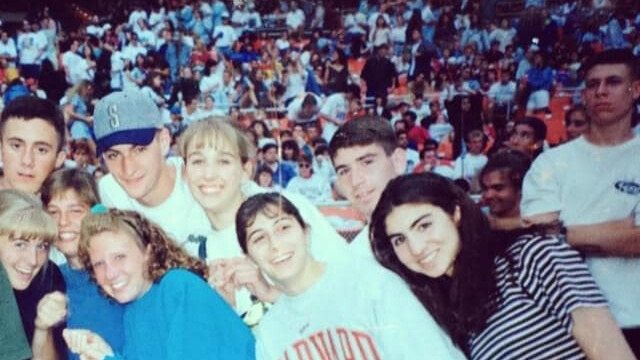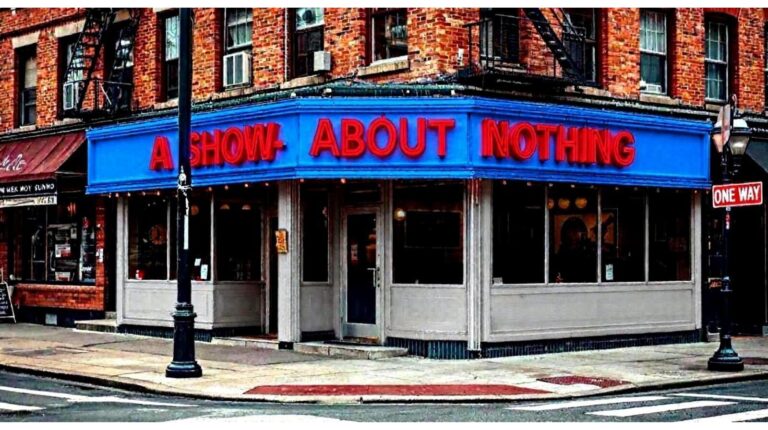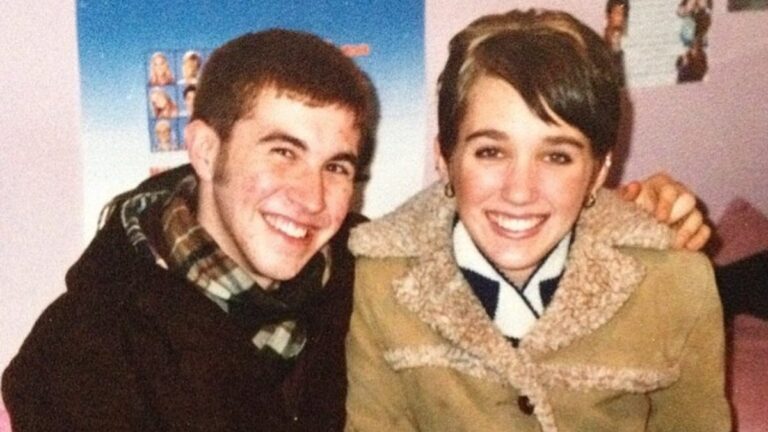The ’90s festival scene changed live music forever. Big names and indie newcomers alike hit the road for sprawling tours that turned into full-blown cultural movements. 1990s music festivals were loud, messy, unforgettable, and it was the blueprint for everything from Coachella to Bonnaroo.
Whether you were crowd-surfing through the chaos or watching from home on MTV, these moments were defining for a generation.
Lollapalooza: The Traveling Revolution
Lollapalooza wasn’t just a festival, it was a roving circus of counterculture. Founded by Jane’s Addiction frontman Perry Farrell in 1991, the tour gave Gen X a new kind of musical home. Each summer, it rolled into amphitheaters and fairgrounds across the country with a lineup that blurred genre lines: grunge, rap, punk, and industrial all shared the same bill.
Lollapalooza also carried a kind of carnival energy that set it apart from other touring shows.
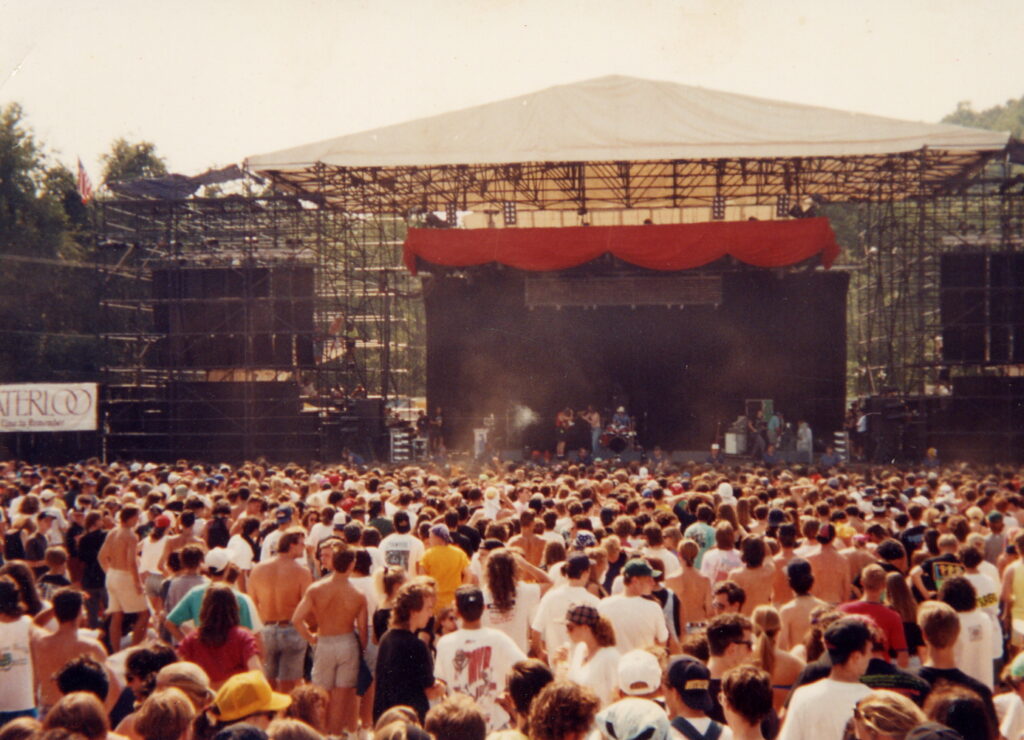
The grounds felt like a mash-up of art installations, merch tents, body-piercing stations, skate ramps, and the occasional sideshow performance. You could watch a punk band melt faces on the main stage, wander past a spoken-word tent, then end up buying incense or a hand-printed zine from someone who looked like they’d been following the tour for weeks.
It was loud, weird, and visually chaotic in a way only the early ’90s could pull off.
It’s also a little bit wistful because, according to all of the people involved with the festival, given the economics of touring now, a festival like this that would tour around the country with this many artists of that stature is actually impossible to do. So it’s really an artifact of a bygone time. It’s not going to happen again. So it’s a celebration of something that can’t be reproduced.
Tom Beaujour, co-writer of “Lollapalooza: The Uncensored Story Of Alternative Rock’s Wildest FestivaL” via NPR
The traveling format made Lollapalooza feel like an annual pilgrimage, a chance to see Nirvana, Soundgarden, Nine Inch Nails, or Rage Against the Machine at their peak, all for the price of one ticket.
H.O.R.D.E. Festival: The Jam Band Caravan
If Lollapalooza was grunge’s playground, H.O.R.D.E. Festival was its jam-band cousin. Founded in 1992 by Blues Traveler’s John Popper, H.O.R.D.E. (short for Horizons of Rock Developing Everywhere) was all about musicianship and marathon live sets.
The rotating lineup included Phish, Spin Doctors, Widespread Panic, and Dave Matthews Band long before they were arena mainstays. The crowd vibe was chill, the air smelled like patchouli and kettle corn, and the solos could last longer than some entire songs.
H.O.R.D.E. carved out its own niche in the 1990s music festival scene, proving that not every tour needed a mosh pit to make history.
Did you know? Early H.O.R.D.E. tickets were inexpensive, which feels like a typo compared with what festivals charge now for parking alone.
Lilith Fair: Empowerment Takes the Main Stage
When Sarah McLachlan launched Lilith Fair in 1997, the industry had a problem: women weren’t getting festival bookings. Lilith Fair fixed that.
The all-female lineup shattered expectations, spotlighting powerhouse voices like Sheryl Crow, Tracy Chapman, Jewel, Fiona Apple, and the Indigo Girls, alongside Sarah McLachlan herself. It wasn’t just about representation, it was about community.
Lilith Fair was created for many reasons: the joy of sharing live music; the connection of like minds; the desire to create a sense of community that I felt was lacking in our industry.
Sarah McLachlan via History
Lilith Fair also had its own look and pace, almost like someone combined a coffeehouse lineup with an outdoor market. People wandered between stages with henna tattoos drying on their hands, blankets across pavilion lawns, and Birkenstocks as go-to footwear. Merch tents stood around the venue and the atmosphere felt slower, calmer, and more intentional than the noisier festivals of the decade.
It was the rare place where you could sit in the grass, hear a crowd actually get quiet during a ballad, and not feel like you were missing something loud happening somewhere else.
Lilith Fair proved that music festivals in the 1990s didn’t have to be fueled by distortion pedals and stage dives. They could celebrate artistry, storytelling, and solidarity instead.
Watch: Lilith Fair: Building a Mystery | Documentary Trailer | Now streaming
Lilith Fair has been getting fresh attention lately, and the trailer below gives a quick look at the voices and performances that shaped the festival’s rise in the 1990s. It captures the mix of artists, crowd energy, and behind-the-scenes moments that made the tour feel different from anything else on the summer festival circuit.
Video via CBC Docs on YouTube
HFStival: The East Coast’s Loudest Secret
While the West had Lollapalooza, the Mid-Atlantic held its own with HFStival, a festival started by legendary D.C. radio station WHFS that ran every summer from 1990 through 2006 and at one point claimed the title of “largest yearly music fest on the East Coast.”
The 1994 HFStival, held at Robert F. Kennedy Memorial Stadium (RFK Stadium) on May 14, brought in around 58,000 attendees across two stages: an inner stadium stage for names like Counting Crows, Cracker and Pavement, and an outer lot stage for local favorites and indie carve-outs.
I still remember being in that crowd — a mix of denim, flannels, concert tees — and the buzz of realizing this East Coast festival packed as much punch as anything out west.

If you loved the big 1990s music festivals like HFStival and Lollapalooza, you’ll probably remember a few from my ’90s summer festivals roundup.
Keep an eye out for the deep-dive about HFStival 1994 coming soon.
Warped Tour: Skating Into the Spotlight
If you grew up with Vans sneakers and a love for ska and pop-punk, Warped Tour was your playground. Launched in 1995, it combined half-pipes, merch tents, and music into a lively summer festival scene.
I treated everyone equally… the smallest bands to the biggest bands, I would try to make sure they had a good experience.
Kevin Lyman (founder) via Wrapbook
The Warped Tour paved the way for new artists in the mid-’90s like Blink-182, Sublime, and No Doubt. It was as much about finding your tribe as it was about catching the next big band before MTV did.
Bands like NOFX and The Mighty Mighty Bosstones drew sweaty crowds to asphalt parking lots across America with its side-by-side stages and pop-up mosh pits, continuing on into the 2000s.
Woodstock ’94 and ’99: Nostalgia Meets Chaos
Woodstock tried to make a comeback. Twice. The 25th-anniversary Woodstock ’94 leaned into nostalgia and mud, mixing legacy acts with ’90s headliners like Green Day and Metallica. Warren Haynes later said playing there gave him “an adrenaline rush” simply because of the sheer size of the crowd.
Five years later, Woodstock ’99 went the opposite direction. Sweltering heat, overpriced water, and a restless crowd pushed the whole thing toward chaos. Performers felt it, too. Tom Morello (guitarist of Rage Against the Machine) called the atmosphere one that “did not echo the peace, love, and understanding of the original Woodstock.”
Watch: Trainwreck: Woodstock ’99 | Official Trailer | Netflix
The trailer below offers a quick look at the buildup and breakdown of Woodstock ’99, showing the heat, the crowds, and the decisions that turned a massive festival into a cautionary tale. It highlights the mix of performances, behind-the-scenes tension, and the larger story of how the event unraveled over one long weekend.
Video via Netflix on YouTube
The two events made it clear how much music festivals in the ’90s had evolved. The decade started with a revival of a 1960s ideal and ended with something that felt more like a warning label.
Did you know? Both Woodstock ’94 and ’99 were broadcast on pay-per-view, making them two of the most-watched live music events of the decade long before streaming made it easy to watch a festival from your couch.
Bonus: The Soundtrack of 1990s Music Festivals
Before you pack your virtual bag for a trip back to those wild weekends, cue up one of these ’90s playlists. They’re ready-made soundtracks for anyone who still remembers the buzz of hearing live guitars echo through the summer air.
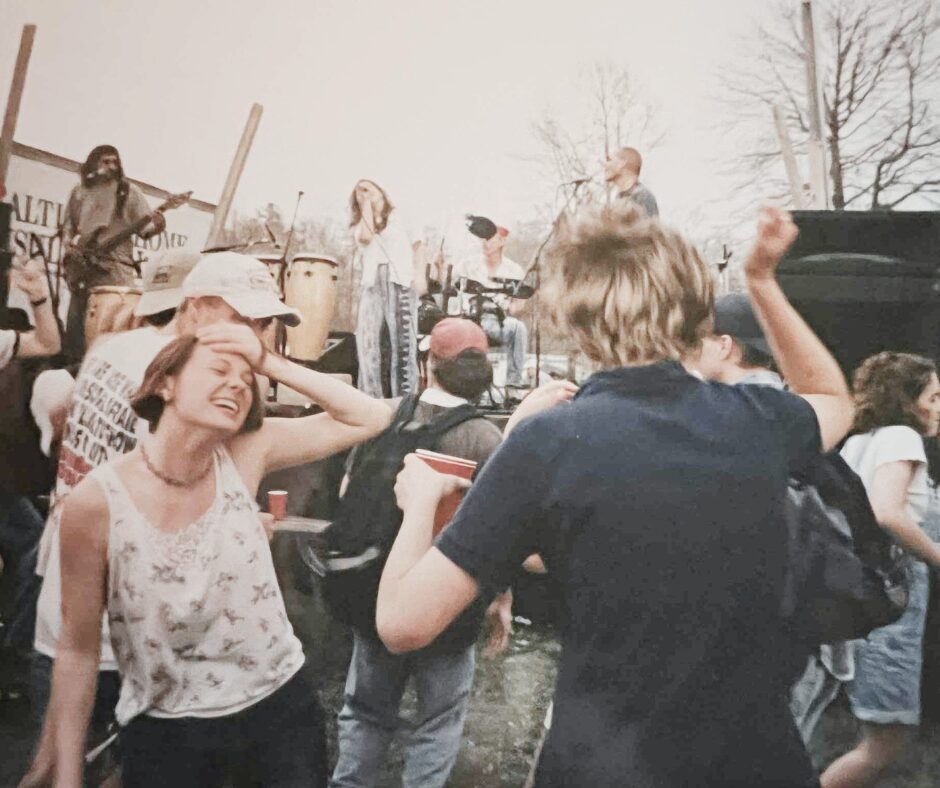
Notable 1990s Music Festivals
If you want the quick roll call, these were the heavy hitters: Lollapalooza, H.O.R.D.E., Lilith Fair, HFStival, Warped Tour, and Woodstock ’99. Each one carved out its own corner of the decade, from jam bands to punk pits to full-scale chaos.
The best thing about music festivals in the 1990s is that they set the bar for everything that came after. The heat, the noise, the sense that you might lose your shoes (or your friends) and never see them again.
Years later, when I ended up at Bonnaroo in 2006, it felt familiar in that “yep, this is still chaos” sort of way. Different decade, same dusty tradition of standing in a field wondering why no one ever remembers sunscreen or water.




